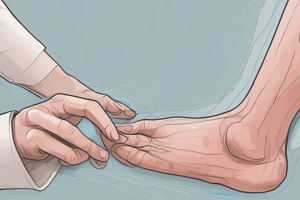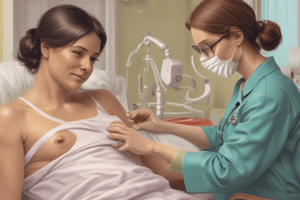Podcast
Questions and Answers
What is the recommended frequency for changing a person's position to prevent pressure ulcers?
What is the recommended frequency for changing a person's position to prevent pressure ulcers?
- Once a day
- Every hour
- Every 2 hours (correct)
- Every 4 hours
What is a major risk factor for pressure ulcer development?
What is a major risk factor for pressure ulcer development?
- Good nutrition
- Fragile, dry skin (correct)
- Good hydration
- Regular exercise
What is an early sign of pressure ulcer development?
What is an early sign of pressure ulcer development?
- Fever
- Redness of the skin (correct)
- Pain at the affected area
- Swelling
What is the purpose of using pressure-reducing devices?
What is the purpose of using pressure-reducing devices?
Why is it important to avoid leaving a person in Fowler's position for an extended period?
Why is it important to avoid leaving a person in Fowler's position for an extended period?
What is the recommended height for elevating the head of the bed?
What is the recommended height for elevating the head of the bed?
Why is it important to remove hair pins or barrettes when a person's head is resting on a pillow?
Why is it important to remove hair pins or barrettes when a person's head is resting on a pillow?
What is the purpose of making a tight, neat, wrinkle-free bed?
What is the purpose of making a tight, neat, wrinkle-free bed?
What is the primary reason for repositioning individuals in a health care setting?
What is the primary reason for repositioning individuals in a health care setting?
What is the benefit of using a sequence of positions in repositioning?
What is the benefit of using a sequence of positions in repositioning?
What is the primary goal of repositioning in the care plan?
What is the primary goal of repositioning in the care plan?
What is the consequence of not repositioning individuals regularly?
What is the consequence of not repositioning individuals regularly?
What is the benefit of using basic positions in the health care setting?
What is the benefit of using basic positions in the health care setting?
What is the purpose of using a specific schedule for repositioning?
What is the purpose of using a specific schedule for repositioning?
What is the characteristic of the supine position?
What is the characteristic of the supine position?
What is the primary goal of repositioning in relation to pressure ulcers?
What is the primary goal of repositioning in relation to pressure ulcers?
What is the primary reason for repositioning a person to prevent pressure ulcers?
What is the primary reason for repositioning a person to prevent pressure ulcers?
Which of the following is not a risk factor for pressure ulcers?
Which of the following is not a risk factor for pressure ulcers?
What is the recommended frequency for checking people with incontinence to prevent pressure ulcers?
What is the recommended frequency for checking people with incontinence to prevent pressure ulcers?
What type of clothing can help prevent pressure ulcers?
What type of clothing can help prevent pressure ulcers?
What is the purpose of elevating a person's arms and legs to prevent pressure ulcers?
What is the purpose of elevating a person's arms and legs to prevent pressure ulcers?
Why is it essential to encourage a person to eat a well-balanced diet to prevent pressure ulcers?
Why is it essential to encourage a person to eat a well-balanced diet to prevent pressure ulcers?
What is the primary purpose of skin-to-skin contact in pressure ulcer prevention?
What is the primary purpose of skin-to-skin contact in pressure ulcer prevention?
What is the recommended action to take when observing skin changes in a person?
What is the recommended action to take when observing skin changes in a person?
Flashcards are hidden until you start studying
Study Notes
Risk Factors for Pressure Ulcer Development
- Immobility is a risk factor for pressure ulcer development
- Advanced age is a risk factor for pressure ulcer development
- Fragile, dry skin is a risk factor for pressure ulcer development
- Moisture (e.g. skin-to-skin contact or contact with soiled linens) is a risk factor for pressure ulcer development
- Poor nutrition is a risk factor for pressure ulcer development
- Poor hydration is a risk factor for pressure ulcer development
- Poor circulation (e.g. due to cardiovascular disease) is a risk factor for pressure ulcer development
- Poor oxygenation (e.g. due to respiratory disease) is a risk factor for pressure ulcer development
Protecting the Person's Skin
- To prevent direct pressure, change the person's position according to the care plan and at least every 2 hours
- Observe and report immediately any reddened, pale, or darkened areas of the skin
- Use pressure-reducing devices (e.g. pressure-reducing mattress pads, heel and elbow protectors) to relieve pressure and protect skin
- To prevent friction and shearing injuries, get help when moving the person, lift the person's body all the way off the mattress, and avoid leaving the person in Fowler's position
- To prevent skin-to-skin contact, check for skin changes under skin folds, position the person to allow air circulation around the arms and legs, and keep skin, clothing, and linens clean and dry
- To prevent moisture damage, wash, rinse, and dry the person's skin thoroughly, especially in areas where skin meets skin
Assisting with Positioning and Transferring
- Repositioning the person often helps to prevent complications such as contractures and pressure ulcers
- Basic positions used in the health care setting include the supine position (bed is flat)
- An individualized schedule for repositioning is part of the person's care plan to reduce the risk of developing pressure ulcers
Studying That Suits You
Use AI to generate personalized quizzes and flashcards to suit your learning preferences.





